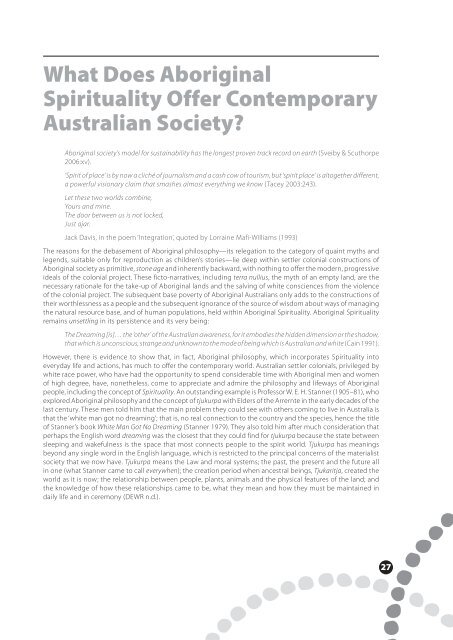DP9-Aboriginal-Spirituality
DP9-Aboriginal-Spirituality
DP9-Aboriginal-Spirituality
Create successful ePaper yourself
Turn your PDF publications into a flip-book with our unique Google optimized e-Paper software.
What Does <strong>Aboriginal</strong><br />
<strong>Spirituality</strong> Offer Contemporary<br />
Australian Society<br />
<strong>Aboriginal</strong> society’s model for sustainability has the longest proven track record on earth (Sveiby & Scuthorpe<br />
2006:xv).<br />
‘Spirit of place’ is by now a cliché of journalism and a cash cow of tourism, but ‘spirit place’ is altogether different,<br />
a powerful visionary claim that smashes almost everything we know (Tacey 2003:243).<br />
Let these two worlds combine,<br />
Yours and mine.<br />
The door between us is not locked,<br />
Just ajar.<br />
Jack Davis, in the poem ‘Integration’, quoted by Lorraine Mafi-Williams (1993)<br />
The reasons for the debasement of <strong>Aboriginal</strong> philosophy—its relegation to the category of quaint myths and<br />
legends, suitable only for reproduction as children’s stories—lie deep within settler colonial constructions of<br />
<strong>Aboriginal</strong> society as primitive, stone age and inherently backward, with nothing to offer the modern, progressive<br />
ideals of the colonial project. These ficto-narratives, including terra nullius, the myth of an empty land, are the<br />
necessary rationale for the take-up of <strong>Aboriginal</strong> lands and the salving of white consciences from the violence<br />
of the colonial project. The subsequent base poverty of <strong>Aboriginal</strong> Australians only adds to the constructions of<br />
their worthlessness as a people and the subsequent ignorance of the source of wisdom about ways of managing<br />
the natural resource base, and of human populations, held within <strong>Aboriginal</strong> <strong>Spirituality</strong>. <strong>Aboriginal</strong> <strong>Spirituality</strong><br />
remains unsettling in its persistence and its very being:<br />
The Dreaming [is]… the ‘other’ of the Australian awareness, for it embodies the hidden dimension or the shadow,<br />
that which is unconscious, strange and unknown to the mode of being which is Australian and white (Cain 1991).<br />
However, there is evidence to show that, in fact, <strong>Aboriginal</strong> philosophy, which incorporates <strong>Spirituality</strong> into<br />
everyday life and actions, has much to offer the contemporary world. Australian settler colonials, privileged by<br />
white race power, who have had the opportunity to spend considerable time with <strong>Aboriginal</strong> men and women<br />
of high degree, have, nonetheless, come to appreciate and admire the philosophy and lifeways of <strong>Aboriginal</strong><br />
people, including the concept of <strong>Spirituality</strong>. An outstanding example is Professor W. E. H. Stanner (1905–81), who<br />
explored <strong>Aboriginal</strong> philosophy and the concept of tjukurpa with Elders of the Arrernte in the early decades of the<br />
last century. These men told him that the main problem they could see with others coming to live in Australia is<br />
that the ‘white man got no dreaming’; that is, no real connection to the country and the species, hence the title<br />
of Stanner’s book White Man Got No Dreaming (Stanner 1979). They also told him after much consideration that<br />
perhaps the English word dreaming was the closest that they could find for tjukurpa because the state between<br />
sleeping and wakefulness is the space that most connects people to the spirit world. Tjukurpa has meanings<br />
beyond any single word in the English language, which is restricted to the principal concerns of the materialist<br />
society that we now have. Tjukurpa means the Law and moral systems; the past, the present and the future all<br />
in one (what Stanner came to call everywhen); the creation period when ancestral beings, Tjukaritja, created the<br />
world as it is now; the relationship between people, plants, animals and the physical features of the land; and<br />
the knowledge of how these relationships came to be, what they mean and how they must be maintained in<br />
daily life and in ceremony (DEWR n.d.).<br />
27


